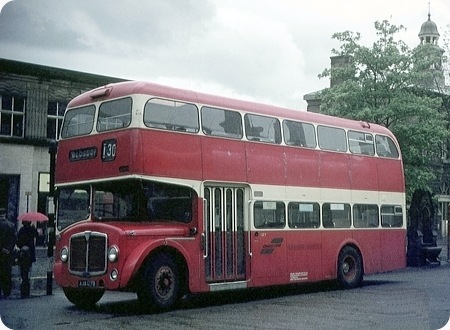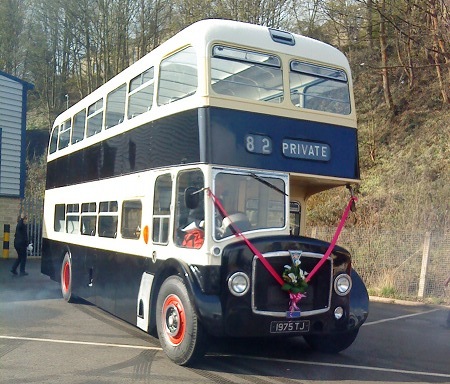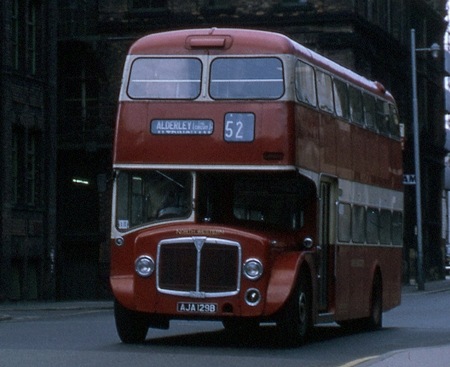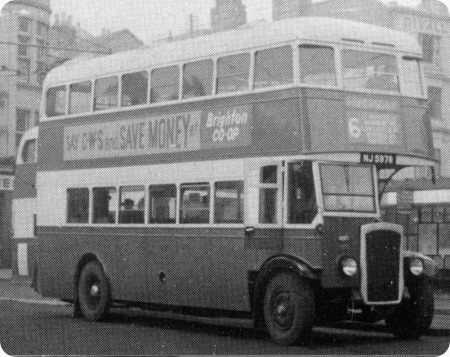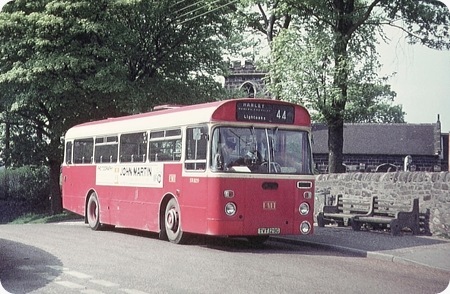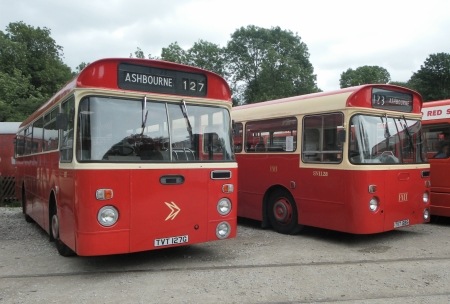North Western – AEC Renown – AJA 127B – 127
North Western Road Car
1964
AEC Renown 3B3RA
Park Royal H42/30F
This former North Western bus still in its original livery but with SELNEC (Cheshire) fleetnames is at the Norfolk Arms terminus in Glossop in May 1972 not long after North Western was split between SELNEC, Trent and Crosville. This was one of the second batch of these buses bought by North Western in this case with forced ventilation evidenced by the lack of opening windows. I wonder how effective this was in dispersing the cigarette smog more or less standard on the upper decks of buses in those days. I pass this location from time to time and wonder at how there could have been a busy bus terminus at such a busy location.
Photograph and Copy contributed by Ian Wild
A full list of Renown codes can be seen here.
———
28/08/12 – 15:17
The Norfolk Arms was busy and similar to the LPTB Hounslow trolleys, the traffic signals were controlled by the driver when ready to depart. I think it was mounted on the pole just by the driver’s cab in the picture. This turned the High St W and E, Victoria St and Norfolk St lights to red and then the bus would sweep out. I have it on good authority this led to at least one conductor being left behind. The old North Westerns from Glossop had a few characters.
Mike Franks
———
28/08/12 – 18:03
I felt bereft, as a student in Manchester, missing my AECs from STD, SUT and the local coach operators. Luckily North Western plied down the Wilmslow and Palatine Roads in student land. It might have been a Fleetline or a Loline but my day was always made when one of these Renowns turned up to take me home.
These PRV bodies have, unfairly in my opinion, been called ugly. Compared with Bridgemasters – especially the forward entrance version – these were positively beautiful, and in their own right were better looking than many contemporaries.
David Oldfield
———
28/08/12 – 18:04
When NBC was set up many fleets were shuffled around like decks of cards, and Northern General was no exception. At Percy Main ‘Tynemouth and Wakefields’ we had a number of Daimler Fleetlines sent off to different areas and got all sorts in return, among the number were six Renown’s that came from East Yorkshire’s fleet. I was in the minority but I quite liked them, especially if you got one on the likes of the 306 or 308 where you had some long gaps between stops, but they could be hard work on some of the town service routes that stopped at every other lamp post.
Ronnie Hoye
———
29/08/12 – 07:59
I have to agree with David that this version of the Park Royal body, combined with North Western’s style of applying the livery, is FAR better than the version on the Bridgemaster or on Southampton’s Regents and PD2As. Those things were little better than shoe boxes with windows. It’s not far off the style Oxford had on their …CWL Regents, and it really was quite good!
Pete Davies
———
29/08/12 – 08:00
I agree with David that the Park Royal Renowns were a big improvement on the Bridgemaster but I wouldn’t go as far as to say they were beautiful. The only Renowns that can justify that accolade in my opinion were the East Lancs bodied versions operated by Leigh Corporation. There were both rear and forward entrance versions in a wonderful blue and cream livery. Fortunately one of the forward entrance vehicles is still with us at Boyle Street museum in Manchester.
Philip Halstead
———
29/08/12 – 08:02
Wearing my driver’s hat, I can imagine a Fleetlines’s attraction for stop start over a manual AEC – much as I personally prefer the latter. Significantly, the North Western Renowns had been "downgraded" from long trunk routes, only to be reinstated by Crosville when they had taken over the Cheshire operations. They claimed they were better out on the open road and could maintain "a head of steam"!
David Oldfield
———
29/08/12 – 10:17
Philip. I did say compared with the Bridgemaster. I would definitely agree with you about the Leigh buses. I used them on the Warrington service when I was doing my post-graduate teacher training at Padgate in the mid ’70s. One or two were still in blue and cream but orange and white was the order of the day. [For new vehicles, I think SELNEC/GMT orange and white was actually quite good even though it did spoil older vehicles in "better" municipal colours.]
David Oldfield
———
29/08/12 – 12:24
As I’ve already said I quite liked the Renown’s, but by the time they came to us most of the routes for which they would have been ideally suited had either gone over to, or were in the process of being changed to OPO, as for them having "a head of steam" they could clip on a bit, and unlike the PD3’s, where after a prolonged spell of stop start braking where the brakes become a tad warm and tend to fade, you could guarantee the Renown’s would stop when asked to.
Ronnie Hoye
———
29/08/12 – 12:24
East Lancs also bodied Renowns for Leicester in both front and rear entrance versions on of the front entrance ones regularly appeared on the rally circuit 190 DBC 190C. My own favourite Renowns were the ones owned by East Yorks in their traditional livery complete with modified upper deck window pillars to negotiate Beverly Bar.
Chris Hough
———
29/08/12 – 12:26
Regarding the beautiful East Lancs-bodied Leigh Renowns, Philip Halstead mentions there is a forward entrance example preserved at the Manchester Museum.
Their rear entrance Renowns were always great favourites of mine ever since I saw the front and rear view photographs of one of them in Buses Illustrated when new. In 1976 I bought 28 (1975 TJ) for preservation from GMPTE, but in the 1980’s sold it and it then passed through several subsequent owners – maintaining a very low profile in the process. Only last week I learned that it been acquired by Tony Blackman for continued preservation, and who knows…..maybe operation in his Yorkshire Heritage Buses wedding hire fleet, though I do hope that it doesn’t turn black and white in the process. The beautiful azure blue and cream Leigh livery would be very much in demand by would-be happy couples I would imagine – it would match the bridesmaids’ dresses and floral arrangements !
John Stringer
———
30/08/12 – 06:49
Leigh 28 at Luddenden Foot, it has been working hard this summer for Yorkshire Heritage Buses. This shot was on her first day in service and as can be seen it is in black & white John.
Geoff S
———
30/08/12 – 07:09
Here is a picture of fellow Renown AJA 129B in Manchester, en route to Alderley in true North Western days. I have to admit that personally I much preferred the North Western Loline IIIs to the Renowns in both appearance and performance, but it would be nice to be able to detect something of the variety and individuality of the psv designs of those times in the present day crop of tediously indistinguishable bus types.
Roger Cox
———
31/08/12 – 07:33
Thanks Geoff S. for sending the photo. I hadn’t realised its restoration had advanced so far, I may well then have seen it at a distance and mistaken it for the ex-Southampton Regent V. As for the livery……….I’ll say no more.
John Stringer
———
31/08/12 – 09:35
Black marks for the new livery, then, John?
David Oldfield
———
31/08/12 – 09:45
Is black a good colour for a wedding or do they do funerals as well.
Spencer
———
So where have you been for the past year and a bit? Have you forgot how to send emails?
Peter
———
31/08/12 – 12:28
It’s a dual-purpose vehicle, Spencer; white for weddings; black for funerals!
Chris Hebbron
———
31/08/12 – 12:29
Tony Blackman’s "new" livery is in fact that of Lockey of West Auckland, and presumably was prompted by his acquisition of a full-fronted Regent V/Park Royal which (although new to East Kent) had been operated by that famous County Durham independent. That particular vehicle also carries Lockeys titles while the rest of the heritage fleet don’t. We all have a lot to thank Tony for – in my personal case for an unforgettable ride through the Mersey Tunnel on his ex-Halifax Regent III. What a pity that his revived Halifax JOC no longer operates stage services in the original glorious livery!
Neville Mercer
———
31/08/12 – 12:30
I suppose so David, but the thought of how it could have looked in its proper livery leaves me feeling blue.
John Stringer
———
31/08/12 – 12:32
The black and cream livery used by Yorkshire heritage buses is derived from the colours on a former East Kent AEC Regent V which is in the livery of its last owner Lockey of St Helens Auckland I saw the ex Darlington Guy saloon in the livery recently and it looked very good indeed. Better in a livery than a scrap yard!
Chris Hough
———
02/09/12 – 07:10
The trouble with Bridgemasters and lowheight Renowns was that there was no inward tapering at the front, creating a profile that was squat and square. That’s why the Beverley Bar treatment is such an improvement – it adds a much-needed bit of shape. Don’t forget Northern Counties www.flickr.com/
Peter Williamson
———
03/10/12 – 06:07
I used to drive these Renowns, 127b, & 129b, in the 60s at the North Western Altrincham Depot , a nice drive but a bit on the ‘Bouncy’ side!!
Roger Williams
———
 Vehicle reminder shot for this posting
Vehicle reminder shot for this posting
———
13/11/12 – 08:44
I was a summer guard with NWRCC at Glossop Garage between 1960 and 1962. It was the guard that operated the lights at the Norfolk Arms terminus and you had to be mighty quick to get back to the platform, clutching Setright and money bag to grasp the platform pole before the driver moved off. Bristol K5G’s were OK but a PD2 was fast off the mark and you held on like grim death for the swing round. Those were the days – swinging loads on the old 125 to Manchester and overloads on the 85 to Buxton on summer days. It was a great company with great mates at Glossop depot. Public service at its best!
Roger Chadwick
———
13/11/12 – 12:57
Roger, be thankful it was a PD2 and not a trolleybus or you’d have been left standing.
Ronnie Hoye
———
23/11/12 – 10:03
Roger, Myself and two colleagues have been researching the North Western driver and conductor duties. Would you have kept any information when you worked at Glossop in the 60’s
Keith Hampton
———
22/01/13 – 06:33
Roger, Being one of the Two colleagues that Keith refers to can you supply any names of staff at all.
All part of an on going, and growing, North Western project of ours.
John Dixon
Quick links to the - Comments Page - Contact Page - Home Page
